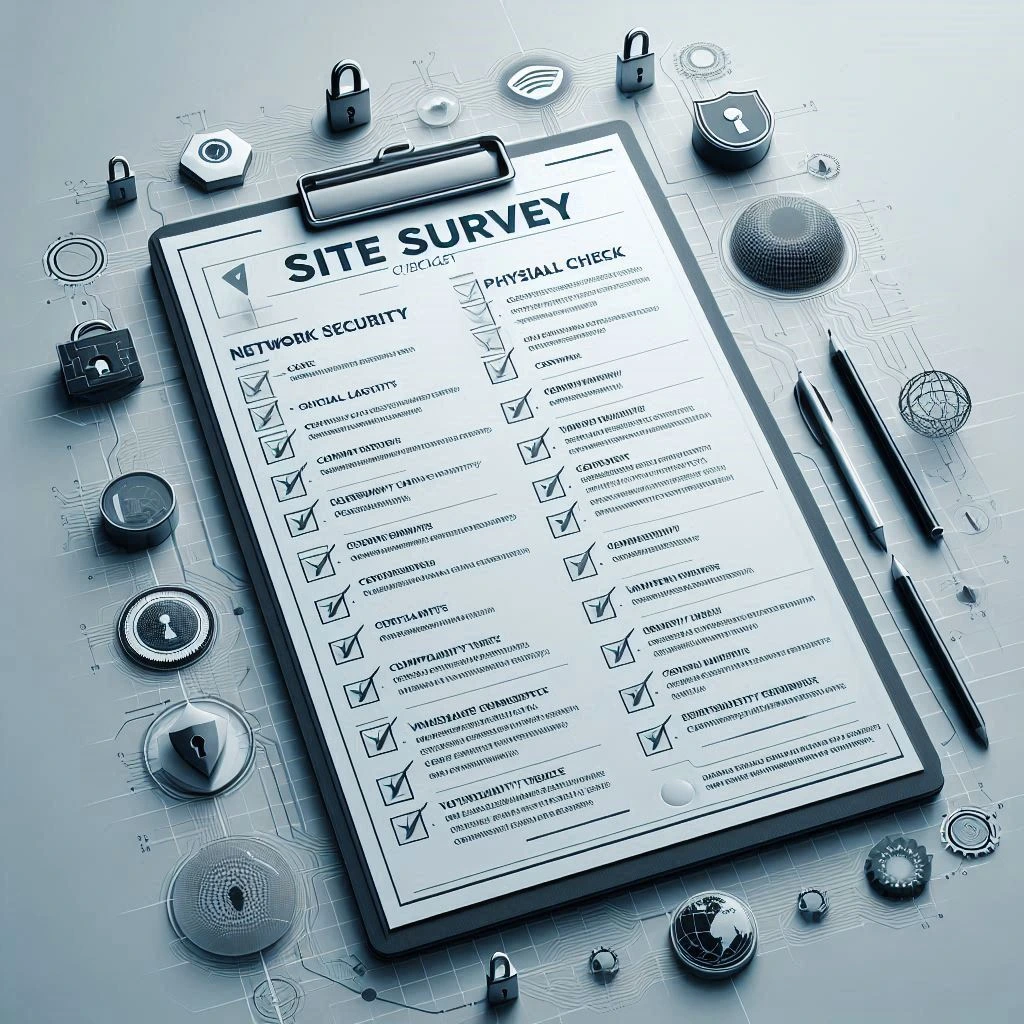Introduction to Site Surveys in Cybersecurity Audits
In the realm of cybersecurity audits, site surveys play a crucial role in assessing the security posture of an organization. A site survey is a comprehensive evaluation of a physical location or wireless network, aimed at identifying potential vulnerabilities and security risks. This process is essential for cybersecurity auditors and internal audit teams, as it provides valuable insights that inform the overall security strategy.
Definition and Role of Site Surveys
Site surveys involve a meticulous examination of various elements within a physical environment, including access points, infrastructure layout, and existing security protocols. By conducting these surveys, auditors can gather critical information about the security landscape, which is vital for identifying weaknesses that could be exploited by malicious actors. The primary objective is to ensure that the environment is secure and that any potential risks are addressed before they can lead to significant breaches or data loss [1][9].
Significance of Thorough Site Surveys
The importance of thorough site surveys cannot be overstated. They serve as the foundation for effective cybersecurity measures by uncovering vulnerabilities that may not be immediately apparent. For instance, unsecured entry points, inadequate surveillance, or poor network configurations can all pose significant risks. By identifying these issues early on, organizations can implement appropriate security measures, thereby reducing the likelihood of successful cyberattacks [1][3]. Regular site surveys also facilitate ongoing assessments of security effectiveness, ensuring that the measures in place remain robust against evolving threats [4].
Relationship Between Site Surveys and Cybersecurity Posture
The relationship between site surveys and an organization’s overall cybersecurity posture is direct and impactful. A well-executed site survey not only identifies vulnerabilities but also contributes to a more comprehensive understanding of the security environment. This understanding allows organizations to prioritize their security efforts effectively, allocate resources where they are most needed, and develop a proactive approach to risk management [5][9]. Ultimately, a thorough site survey enhances the organization’s ability to protect its digital assets and maintain compliance with industry standards and regulations [10][12].
Site surveys are an indispensable component of cybersecurity audits. They provide the necessary context and insights that enable internal auditors and cybersecurity teams to fortify their defenses and ensure a resilient security posture. By incorporating a practical checklist for site surveys, auditors can systematically address potential vulnerabilities and enhance the overall security framework of their organization.
Understanding the Scope of the Site Survey
When conducting a site survey for cybersecurity audits, it is crucial to clearly define the scope and objectives to ensure a thorough and effective assessment. Here are the key points to consider:
- Identify Specific Systems, Networks, and Physical Locations: Begin by pinpointing the exact systems and networks that will be included in the survey. This may involve identifying critical infrastructure, data centers, and any remote locations that house sensitive information. Understanding the physical layout and the technology in use is essential for a comprehensive evaluation of potential vulnerabilities.
- Discuss Stakeholder Engagement: Engaging stakeholders is vital for gathering insights and ensuring that the survey addresses all relevant concerns. This includes collaborating with IT teams, management, and other departments that may be affected by cybersecurity policies. Their input can help refine the scope, ensuring that all critical areas are covered and that the survey aligns with organizational goals.
- Outline Objectives: Clearly define the objectives of the site survey. Common objectives may include:
- Compliance Checks: Ensuring that the organization adheres to relevant regulations and standards, such as GDPR, HIPAA, or PCI-DSS.
- Risk Assessments: Identifying potential risks and vulnerabilities within the systems and networks to prioritize remediation efforts.
- Operational Effectiveness: Evaluating the effectiveness of current cybersecurity measures and identifying areas for improvement.
By establishing a well-defined scope and clear objectives, cybersecurity auditors can conduct site surveys that are not only thorough but also aligned with the organization’s strategic goals. This structured approach will facilitate a more effective audit process, ultimately enhancing the organization’s cybersecurity posture.
Essential Elements of a Site Survey Checklist
When conducting a site survey for cybersecurity audits, it is crucial to have a comprehensive checklist that covers all critical areas. This ensures that auditors and cybersecurity teams can identify vulnerabilities and enhance the overall security posture of the organization. Below are the essential elements to include in your site survey checklist:
- Inventory of All Hardware and Software Assets: Begin by cataloging all hardware and software within the organization. This includes servers, workstations, network devices, and applications. Understanding what assets are present is fundamental for assessing their security and ensuring they are adequately protected against potential threats [3][8].
- Assessment of Physical Security Measures: Evaluate the physical security controls in place, such as access controls (e.g., key cards, biometric systems) and surveillance systems (e.g., cameras, motion detectors). This assessment helps identify any weaknesses in the physical barriers that could allow unauthorized access to sensitive areas [4][8].
- Evaluation of Network Security Configurations and Policies: Review the configurations of network devices, including firewalls, routers, and switches. Ensure that security policies are in place and enforced, such as segmentation of networks and the use of secure protocols. This evaluation is vital for protecting the organization from external and internal cyber threats [5][7].
- Review of Data Protection Measures: Analyze the measures implemented for data protection, including encryption protocols for data at rest and in transit, as well as backup solutions. Ensuring that data is adequately protected against breaches and loss is a critical component of any cybersecurity strategy [5][7].
- Analysis of User Access Controls and Identity Management Practices: Examine how user access is managed within the organization. This includes reviewing identity management practices, such as user provisioning and de-provisioning, as well as access controls to sensitive data and systems. Proper management of user access is essential to prevent unauthorized access and potential data breaches [5][7].
By incorporating these elements into your site survey checklist, internal auditors and cybersecurity teams can conduct thorough assessments that not only identify vulnerabilities but also provide actionable insights to strengthen the organization’s cybersecurity framework.
Conducting the Site Survey: Best Practices
When it comes to conducting a site survey for cybersecurity audits, having a structured approach is essential. This section provides practical advice and best practices to ensure that internal auditors and cybersecurity teams can execute site surveys effectively.
Tips for Gathering Information
Interviews:
- Engage with key personnel, including IT staff, security officers, and end-users. Prepare open-ended questions that encourage detailed responses about current security practices and potential vulnerabilities.
- Document insights from these interviews to identify patterns or recurring issues that may need further investigation.
Observations:
- Conduct on-site observations to assess physical security measures, such as access controls, surveillance systems, and the overall security posture of the environment.
- Pay attention to the configuration of hardware and software, ensuring that they align with established security policies and best practices.
Documentation Review:
- Review existing security policies, incident reports, and previous audit findings. This will provide context and help identify areas that require deeper scrutiny.
- Ensure that all documentation is up-to-date and reflects the current operational environment, as outdated information can lead to misinformed assessments.
Best Practices for Collaboration
Establish Clear Communication:
- Foster open lines of communication between auditors and cybersecurity teams. Regular meetings can help clarify objectives, share findings, and address any concerns that arise during the survey process.
- Utilize collaborative tools to share documents and findings in real-time, ensuring that all team members are on the same page.
Define Roles and Responsibilities:
- Clearly outline the roles of each team member involved in the site survey. This helps to avoid overlaps and ensures that all aspects of the survey are covered efficiently.
- Encourage team members to leverage their unique expertise, whether in technical assessments or policy evaluations, to enhance the overall quality of the survey.
Importance of Objectivity and Thoroughness
Maintain Objectivity:
- It is crucial for auditors to approach the site survey with an unbiased perspective. This means setting aside preconceived notions and focusing on factual evidence gathered during the survey.
- Objectivity helps in accurately identifying vulnerabilities and assessing the effectiveness of existing security measures without being influenced by personal opinions or external pressures.
Ensure Thoroughness:
- A comprehensive site survey should cover all relevant areas, including physical security, network configurations, and compliance with security policies.
- Utilize a checklist to ensure that no critical components are overlooked. Regularly update this checklist based on evolving threats and organizational changes to maintain its relevance.
By following these best practices, internal auditors and cybersecurity teams can conduct effective site surveys that not only identify vulnerabilities but also contribute to the overall enhancement of the organization’s cybersecurity posture. Regular assessments and updates are vital to staying aligned with the ever-evolving threat landscape, ensuring that security measures remain robust and effective [1][8][15].
Common Challenges in Site Surveys and How to Overcome Them
Conducting site surveys for cybersecurity audits is a critical step in assessing an organization’s security posture. However, auditors often encounter several challenges that can hinder the effectiveness of these surveys. Below are some common obstacles and practical solutions to address them.
1. Identifying Resistance from Staff or Management
Resistance from staff or management can significantly impede the site survey process. Employees may feel threatened by the audit, fearing repercussions or disruptions to their workflow. To mitigate this challenge:
- Communicate Clearly: Prior to the survey, communicate the purpose and benefits of the audit to all stakeholders. Emphasize that the goal is to enhance security and protect the organization rather than to assign blame.
- Involve Key Personnel: Engage key staff members in the planning stages of the audit. Their involvement can foster a sense of ownership and reduce resistance.
- Provide Training: Offer training sessions to educate staff about the importance of cybersecurity and how their cooperation can lead to a more secure environment.
2. Dealing with Incomplete or Outdated Documentation
Incomplete or outdated documentation can lead to gaps in understanding the current security landscape, making it difficult to conduct a thorough site survey. To overcome this issue:
- Pre-Survey Document Review: Before the site survey, review existing documentation to identify any gaps. This includes policies, procedures, and previous audit reports.
- Conduct Interviews: Engage with staff to gather insights and fill in the gaps in documentation. This can provide a more accurate picture of the current security measures in place.
- Establish a Documentation Process: Implement a process for regularly updating and maintaining documentation to ensure it remains current and comprehensive.
3. Managing Time Constraints and Resource Limitations
Time constraints and limited resources can pose significant challenges during site surveys, potentially leading to rushed assessments and overlooked vulnerabilities. To effectively manage these limitations:
- Prioritize Key Areas: Focus on high-risk areas first. Conduct a risk assessment to identify which systems or processes require immediate attention.
- Utilize Technology: Leverage cybersecurity tools and software to streamline the survey process. Automated tools can help gather data more efficiently and reduce the manual workload.
- Plan Ahead: Develop a detailed survey plan that outlines timelines, resource allocation, and responsibilities. This can help ensure that the survey is conducted systematically and efficiently.
By addressing these common challenges, cybersecurity auditors can enhance the effectiveness of their site surveys, leading to more comprehensive assessments and improved security measures within the organization.
Post-Survey Analysis and Reporting
After conducting a site survey for cybersecurity, the next crucial step is to analyze the findings and report them effectively. This process not only helps in identifying vulnerabilities but also ensures that stakeholders are informed and can take actionable steps based on the survey results. Here’s a practical checklist to guide internal auditors and cybersecurity teams through this phase:
1. Analyzing Collected Data
- Data Compilation: Gather all data collected during the site survey, including notes on physical access points, infrastructure layout, and security protocols. This comprehensive dataset is essential for a thorough analysis [3].
- Identifying Trends: Utilize analytical methods to identify patterns or trends in the data. Look for common vulnerabilities, such as unsecured entry points or inadequate surveillance coverage, which may indicate systemic issues [1][3].
- Risk Assessment: Evaluate the potential impact of identified vulnerabilities on the organization’s security posture. This assessment should prioritize risks based on their likelihood and potential consequences [7].
2. Structuring the Audit Report
- Executive Summary: Begin the report with a succinct executive summary that encapsulates the key findings and overall security posture. This section should address high-level concerns relevant to leadership [13].
- Detailed Findings: Organize the report to highlight specific vulnerabilities and risks identified during the survey. Use clear headings and bullet points to make the information easily digestible [8].
- Recommendations: Provide actionable recommendations for each identified issue. This could include suggestions for improving security protocols, enhancing surveillance, or addressing physical security weaknesses [1][4].
3. Communicating Results to Stakeholders
- Presentation of Findings: Prepare a presentation or meeting to discuss the findings with stakeholders. Use visual aids, such as charts and graphs, to illustrate trends and vulnerabilities effectively [2].
- Actionable Follow-Up: Ensure that the report includes a clear plan for follow-up actions. This should outline who is responsible for implementing recommendations and the timeline for these actions [8].
- Feedback Loop: Establish a mechanism for stakeholders to provide feedback on the report and the proposed actions. This engagement can help refine future site surveys and improve overall security measures [4].
By following this checklist, internal auditors and cybersecurity teams can ensure that their site survey findings are not only analyzed thoroughly but also communicated effectively, leading to improved security outcomes for the organization.
Continuous Improvement: Updating the Site Survey Checklist
In the realm of cybersecurity audits, the effectiveness of a site survey checklist hinges on its ability to adapt to the ever-evolving landscape of threats and vulnerabilities. Regularly updating this checklist is not just a best practice; it is essential for maintaining robust security measures. Here are key points to consider for continuous improvement:
- Encouraging Feedback from Audit and Cybersecurity Teams Post-Survey: After conducting a site survey, it is crucial to gather insights and feedback from both the audit and cybersecurity teams. This collaborative approach allows for the identification of gaps in the checklist and highlights areas that may require additional focus. Engaging these teams fosters a culture of continuous improvement and ensures that the checklist remains relevant and effective in addressing real-world challenges [1][2].
- Staying Informed About New Cybersecurity Threats and Best Practices: The cybersecurity landscape is dynamic, with new threats emerging regularly. Internal auditors and cybersecurity teams should prioritize staying informed about these developments. This can be achieved through continuous education, attending industry conferences, and subscribing to relevant publications. By integrating the latest threat intelligence and best practices into the checklist, organizations can enhance their preparedness and response capabilities [3][4].
- Establishing a Schedule for Periodic Reviews and Updates of the Checklist: To ensure that the site survey checklist remains effective, it is important to establish a regular review schedule. This could be quarterly, bi-annually, or annually, depending on the organization’s risk profile and the frequency of changes in the cybersecurity landscape. During these reviews, teams should assess the checklist against current threats, regulatory requirements, and technological advancements, making necessary adjustments to keep it aligned with best practices.
By implementing these strategies, internal auditors and cybersecurity teams can create a living document that evolves alongside the threats it aims to mitigate. This proactive approach not only strengthens the organization’s security posture but also fosters a culture of vigilance and adaptability in the face of emerging risks.
Conclusion and Next Steps
In the realm of cybersecurity audits, conducting thorough site surveys is paramount. These assessments not only help identify potential vulnerabilities within an organization’s infrastructure but also play a crucial role in ensuring that security measures are effectively implemented. A well-executed site survey can significantly enhance the overall security posture by providing insights into both physical and digital risks that may threaten sensitive information and systems. By recognizing the importance of these surveys, internal auditors and cybersecurity teams can proactively address security challenges before they escalate into serious issues.
As you consider the checklist provided, it is essential to remember that one size does not fit all. Each organization has unique requirements and risk profiles, so customizing the checklist to fit your specific context is vital. Tailoring the checklist will ensure that it addresses the particular challenges and needs of your organization, ultimately leading to more effective audits and security measures.
Moreover, the field of cybersecurity is ever-evolving, with new threats and technologies emerging regularly. Therefore, embracing a mindset of continuous learning and adaptation is crucial for internal auditors and cybersecurity professionals. Staying informed about the latest trends, tools, and best practices will not only enhance your auditing capabilities but also contribute to a more resilient security framework within your organization. By committing to ongoing education and flexibility in your approach, you can ensure that your site surveys remain relevant and effective in mitigating risks.
In summary, thorough site surveys are a foundational element of successful cybersecurity audits. By customizing your checklist and fostering a culture of continuous improvement, you can significantly enhance your organization’s security posture and readiness to face the challenges of an increasingly complex digital landscape.
Find out more about Shaun Stoltz https://www.shaunstoltz.com/about/
This post was written by an AI and reviewed/edited by a human.



